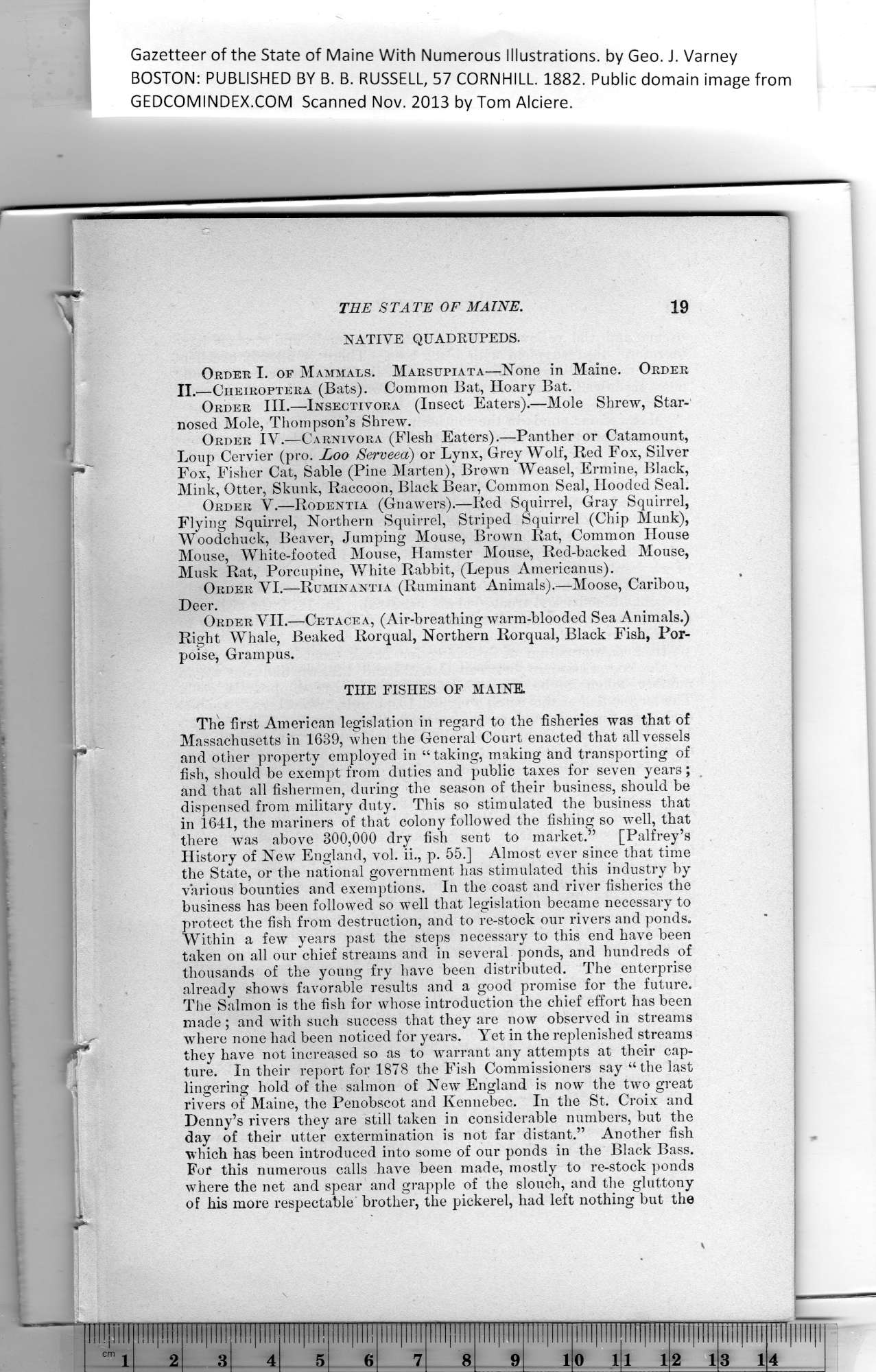|
Gazetteer of the State of Maine With Numerous Illustrations, by Geo. J. Varney
BOSTON: PUBLISHED BY B. B. RUSSELL, 57 CORNHILL. 1882. Public domain image from
THE STATE OF MAINE. 19
NATIVE QUADRUPEDS.
Order I. oe Mammals. Marsupiata—None in Maine. Order
II.—Cheiroptera (Bats). Common Bat, Hoary Bat.
Order III.—Insectivora (Insect Eaters).—Mole Shrew, Star-
nosed Mole, Thompson’s Shrew.
Order IV.—Carnivora (Flesh Eaters).—Panther or Catamount,
Loup Cervier (pro. Loo Serveea) or Lynx, Grey Wolf, Red Fox, Silver
Fox, Fisher Cat, Sable (Pine Marten), Brown Weasel, Ermine, Black,
Mink, Otter, Skunk, Raccoon, Black Bear, Common Seal, Hooded Seal.
Order V.—Rodentia (Gnawers).—Red Squirrel, Gray Squirrel,
Flying Squirrel, Northern Squirrel, Striped Squirrel (Chip Munk),
Woodchuck, Beaver, Jumping Mouse, Brown Rat, Common House
Mouse, White-footed Mouse, Hamster Mouse, Red-backed Mouse,
Musk Rat, Porcupine, White Rabbit, (Lepus Americanus).
Order VI.—Ruminantia (Ruminant Animals).—Moose, Caribou,
Deer.
Order VII.—Cetacea, (Air-breathing wTarm-blooded Sea Animals.)
Rigbt Whale, Beaked Rorqual, Northern Rorqual, Black Fish, Por-
poise, Grampus.
THE FISHES OF MAINE.
The first American legislation in regard to the fisheries was that of
Massachusetts in 1639, when the General Court enacted that all vessels
and other property employed in “taking, making and transporting of
fish, should be exempt from duties and public taxes for seven years;
and that all fishermen, during the season of their business, should be
dispensed from military duty. This so stimulated the business that
in 1641, the mariners of that colony followed the fishing so well, that
there was above 300,000 dry fish sent to market.” [Palfrey’s
History of New England, vol. ii., p. 55.] Almost ever since that time
the State, or the national government has stimulated this industry by
various bounties and exemptions. In tbe coast and river fisheries the
business has been followed so well that legislation became necessary to
protect the fish from destruction, and to re-stock our rivers and ponds.
Within a few years past the steps necessary to this end have been
taken on all our chief streams and in several ponds, and hundreds of
thousands of the young fry have been distributed. The enterprise
already shows favorable results and a good promise for the future.
The Salmon is the fish for whose introduction the chief effort has been
made; and with such success that they are now observed in streams
where none had been noticed for years. Yet in the replenished streams
they have not increased so as to warrant any attempts at their cap-
ture. In their report for 1878 the Fish Commissioners say “ the last
lingering hold of the salmon of New England is now the two great
rivers of Maine, the Penobscot and Kennebec. In the St. Croix and
Denny’s rivers they are still taken in considerable numbers, but the
day of their utter extermination is not far distant.” Another fish
which has been introduced into some of our ponds in the Black Bass.
For this numerous calls have been made, mostly to re-stock ponds
where the net and spear and grapple of the slouch, and the gluttony
of his more respectable brother, the pickerel, had left nothing but the
PREVIOUS PAGE ... NEXT PAGE
This page was written in HTML using a program written in Python 3.2
|
